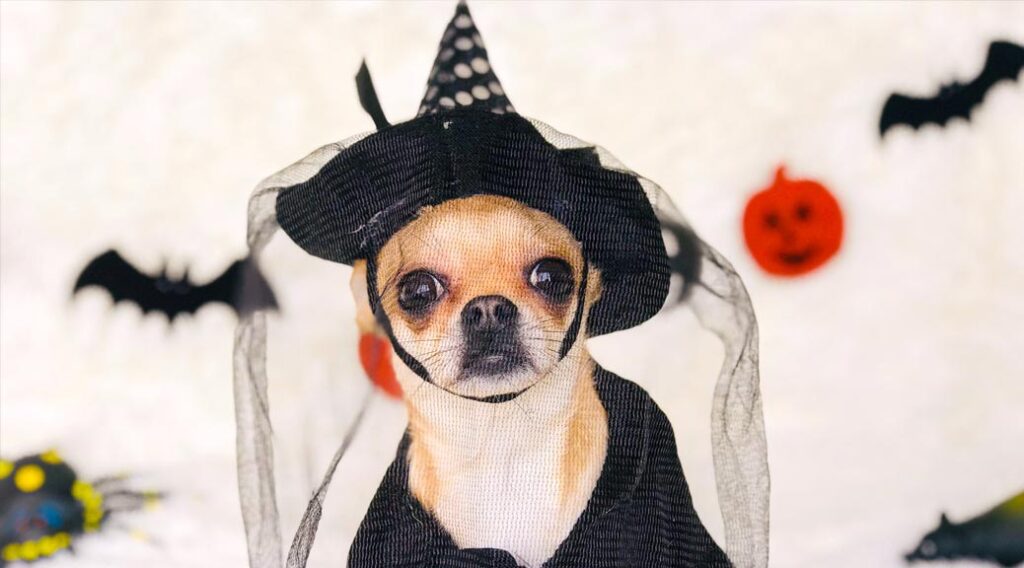Halloween can be fun for humans, but for pets, it can be a scary, dangerous experience.
Noisy bands of masked strangers at your door, bowls and bags filled with tempting candy, unfamiliar decorations to explore and costumes for the entire family can put your pet at risk of being lost, stressed, ill or injured.
Here are some precautions we recommend to safeguard your pet this Halloween.
Don’t Share the Treats
Make sure your children and all the adults in your household know not to share Halloween treats with your pets. Keep the candy you are giving out and the candy your children collect securely out of your pet’s reach.
Just about any sugary or fatty candy, cakes and cookies can cause your pet to experience vomiting and diarrhea, but the theobromine and caffeine in chocolate are especially dangerous and can overstimulate a dog’s nervous system to life-threatening levels.
Treats sweetened with xylitol can quickly lower a dog’s blood sugar level and can lead to liver failure.
“Healthy” treats containing raisins, grapes or macadamia nuts can be toxic—even fatal—to pets. For example, as few as 5 to 20 raisins can cause kidney failure in a small dog.
Depending on your pet’s size and the amount your pet eats, indulging in Halloween treats can cause pancreatitis or hemorrhagic gastroenteritis, triggering vomiting and diarrhea that can lead to severe dehydration. Both conditions require prompt veterinary care and possible hospitalization.
A pet who discovers a bag filled with treats may well eat wrappers and sticks along with the candy. These materials can get stuck in your pet’s stomach and block or possibly rupture the intestines. Surgery will most likely be required.
And if your pet indulges in an assortment of candy collected throughout the neighborhood, you will have no way of knowing just what potential toxins your pet may have ingested.
Keep Decorations Out of Reach
Strings of lights can cause electrical shocks and swallowed glass and plastic shards.
Candles can cause burns and, if tipped over, can start a fire.
Moldy pumpkins can cause tremors in dogs if they snack on jack-o-lanterns.
Cobweb decorations are especially tempting to cats and kittens, with potentially serious results if the fake web gets wrapped around the tongue. If pets swallow the stringy cobweb material, it may require surgery to remove the blockage.
Mind the Costumes
If you plan to dress your pet in its own Halloween costume, make sure the costume you choose is one your pet can and will tolerate comfortably.
The costume should not block your pet’s sight, hearing, breathing or movement. There should be no rubber bands, tight strings or straps to cut off circulation or breathing. Wide Velcro fasteners are preferable.
A costume can become a choking hazard if the pet chews off and swallows pieces or becomes entangled in the fabric while trying to wriggle out of it. Swallowed costume pieces can cause a blockage that requires surgery to remove.
Supervise your costumed pet at all times. If you need to leave your pet unattended—even for only a few minutes—remove the costume first.
If you and your family are wearing costumes, you may frighten your pet. Make sure you introduce yourselves in costume to your pet in a reassuring, non-threatening way.
Recognize the Dangers of Trick or Treating
For most dogs, trick-or-treating from door-to-door with your family—especially in a busy neighborhood with other trick-or-treaters filling the streets—can be a stressful experience.
Even the calmest, friendliest dog is likely to get spooked by all the strange-looking people, noise and confusion. Some dogs may even try to protect you from costumed, masked people who seem to present a threat.
As a kindness to your pet, we recommend you remove the cute costume and leave him or her at home.
If you stay home to dispense treats, your pet may be startled and stressed by all the doorbell-ringing and shouting for hours on end and may dash out the open door, risking being lost or hit by a car. If weather permits, you may minimize the disruption by greeting trick-or-treaters outdoors on the front porch.
Bring outdoor pets—especially black cats—inside on Halloween to safeguard them from being stolen and possibly abused by cruel pranksters.
All pets will tolerate Halloween best if crated and kept in a quiet room with the door closed.
Just in case your frightened pet does escape through an open door, make sure he or she has proper identification—a microchip and a collar with identification tags—to help get back home.

